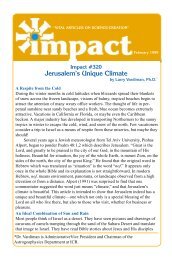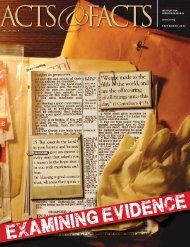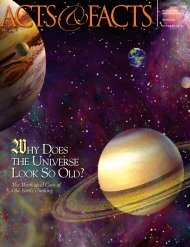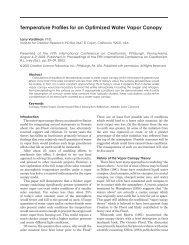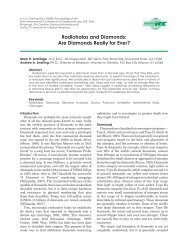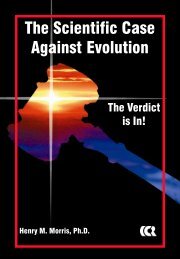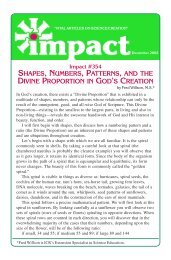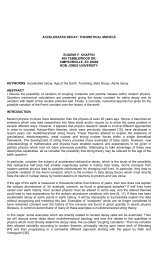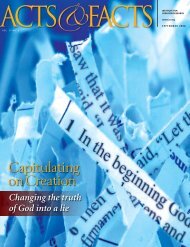the profusion of living fossils - Institute for Creation Research
the profusion of living fossils - Institute for Creation Research
the profusion of living fossils - Institute for Creation Research
You also want an ePaper? Increase the reach of your titles
YUMPU automatically turns print PDFs into web optimized ePapers that Google loves.
No. 143“LORD, how manifold are thy works!In wisdom hast thou made <strong>the</strong>m all:<strong>the</strong> earth is full <strong>of</strong> thy riches”(Psalm 104:24).”November 2000THE PROFUSION OF LIVING FOSSILSEvolutionists consider what <strong>the</strong>y call“<strong>living</strong> <strong>fossils</strong>” to be rare, <strong>the</strong> famous Coelacanthfish being <strong>the</strong> best-known example.The <strong>fossils</strong> <strong>of</strong> this fish are foundonly in rocks older than 70 million years(assuming <strong>the</strong> standard geologic timescale to be real), but <strong>living</strong> coelacanthshave been found in <strong>the</strong> Indian Ocean.New cases <strong>of</strong> so-called <strong>living</strong> <strong>fossils</strong>do turn up fairly <strong>of</strong>ten. Graptolites havebeen considered in <strong>the</strong> past to be index<strong>fossils</strong> <strong>for</strong> <strong>the</strong> Ordovician period, 300 millionyears old. Yet <strong>the</strong>y recently werefound still <strong>living</strong> in <strong>the</strong> south Pacific. 1O<strong>the</strong>r famous <strong>living</strong> <strong>fossils</strong> include<strong>the</strong> tuatara (supposedly extinct since <strong>the</strong>Cretaceous Period until found still <strong>living</strong>in New Zealand), <strong>the</strong> Lepidocaris crustacean(only found as <strong>fossils</strong> in Devonianrocks), <strong>the</strong> Metasequoia conifer tree(thought extinct <strong>for</strong> <strong>the</strong> past 20 millionyears), <strong>the</strong> Neopilina mollusk (supposedlyextinct <strong>for</strong> 280 million years), <strong>the</strong>lingula brachiopod (“extinct” since <strong>the</strong>Ordovician), and even <strong>the</strong> trilobite (chiefindex fossil <strong>of</strong> <strong>the</strong> even more ancient CambrianPeriod). 2Evolutionists tend to reserve <strong>the</strong> title<strong>of</strong> “<strong>living</strong> fossil” <strong>for</strong> those animals andplants which had been considered extinctuntil suddenly <strong>the</strong>y turned up <strong>living</strong> today.Consequently, <strong>the</strong> vast numbers <strong>of</strong><strong>living</strong> organisms that were already knownby Henry M. Morris, Ph.D.*to be in <strong>the</strong> fossil record are generallyignored as examples <strong>of</strong> <strong>living</strong> <strong>fossils</strong>.These even include those organisms supposedto be <strong>the</strong> most ancient <strong>of</strong> all. Evolutionis supposed to have begun whenprokaryotes evolved out <strong>of</strong> <strong>the</strong> primevalsoup. It is significant, <strong>the</strong>re<strong>for</strong>e, that:Fossils very similar to <strong>living</strong>prokaryotes are found in rocksabout 3500 million years old. 3Likewise, <strong>the</strong> primitive one-celledorganisms called eukaryotes are supposedto have evolved from prokaryotes.But, <strong>the</strong>se also are still <strong>living</strong>, essentiallyunchanged, in <strong>the</strong> modern world.Simple eukaryotes, resembling<strong>living</strong> unicellular algae, are firstconfirmed in <strong>the</strong> fossil recordabout 1500 million years ago andfirst suspected in rocks almost2000 million years old. 4The most important modern prokaryotesare probably <strong>the</strong> bacteria and <strong>the</strong>blue-green algae, and <strong>the</strong>se certainlyshould be considered <strong>living</strong> <strong>fossils</strong>. Theyhave been found in abundance in 3.4 billionyear-old rocks from South America.Modern soil bacteria have been found inPrecambrian rocks. One wonders why, ifevolution really works, <strong>the</strong>se “primitive”organisms have not changed significantlyin over a billion years.The prolific evolutionist, Stephen Jay*Dr. Morris is Founder and President Emeritus <strong>of</strong> ICR.a
Gould, has insisted that <strong>the</strong>re is no evidencewhatever against evolution. Yet hestresses <strong>the</strong> fact that bacteria havechanged little since ancient times.The most salient feature <strong>of</strong> lifehas been <strong>the</strong> stability <strong>of</strong> its bacterialmode from <strong>the</strong> beginning <strong>of</strong><strong>the</strong> fossil record until today and,with little doubt, into all futuretime so long as <strong>the</strong> Earth endures.5The same situation applies throughout<strong>the</strong> geologic column. In <strong>the</strong> supposed“oldest” period with metazoan <strong>fossils</strong>, all<strong>the</strong> present-day animal phyla are foundas <strong>fossils</strong>, largely in modern <strong>for</strong>m. AsGould says:In one <strong>of</strong> <strong>the</strong> most crucial andenigmatic episodes in <strong>the</strong> history<strong>of</strong> life, . . . nearly all animal phylamade <strong>the</strong>ir first appearance in <strong>the</strong>fossil record at essentially <strong>the</strong>same time, an interval <strong>of</strong> some 5million years (about 525 to 530million years ago) called <strong>the</strong>Cambrian explosion. 6Speaking <strong>of</strong> <strong>the</strong> Cambrian fauna,<strong>the</strong>re are many that still survive, all lookingmuch like <strong>the</strong>y did over 500 millionyears ago. The prominent British evolutionists,Richard Dawkins, has made <strong>the</strong>following comment:And we find many <strong>of</strong> <strong>the</strong>m alreadyin an advanced state <strong>of</strong> evolution,<strong>the</strong> very first time <strong>the</strong>y appear.It is as though <strong>the</strong>y were justplanted <strong>the</strong>re, without any evolutionaryhistory. Needless to say,this appearance <strong>of</strong> sudden plantinghas delighted creationists. 7Indeed it has. Until recently, <strong>the</strong> phylum<strong>of</strong> vertebrates had been considered alater arrival in evolutionary history. Butnot now! Even <strong>the</strong> vertebrate phylum nowextends into <strong>the</strong> Cambrian period, especiallywith <strong>the</strong> recent discovery <strong>of</strong> tw<strong>of</strong>ossil fish in China:bThe two new <strong>fossils</strong> . . . fromChengjiang are <strong>the</strong> most convincingEarly Cambrian vertebratesever found. 8The insects and o<strong>the</strong>r land invertebratesare also a very important group,and <strong>the</strong>se practically all seem to be <strong>living</strong><strong>fossils</strong>. With respect to <strong>the</strong> arthropodphylum (<strong>the</strong> largest in <strong>the</strong> animal kingdom),consider <strong>the</strong> millipedes, <strong>for</strong> example.Indeed, <strong>the</strong> oldest <strong>fossils</strong> <strong>of</strong> landdwellinganimals are millipedes,dating to more than 425 millionyears ago. Incredibly, <strong>the</strong> archaic<strong>for</strong>ms are nearly indistinguishablefrom certain groups <strong>living</strong>today. 9The same phenomenon holds <strong>for</strong> practicallyall <strong>the</strong> insects.Compared with o<strong>the</strong>r life <strong>for</strong>ms,insects are actually slow to evolvenew families—but <strong>the</strong>y are evenslower to go extinct. Some 84 percent<strong>of</strong> <strong>the</strong> insect families alivetoday were alive 100 millionyears ago. . . . 10Whe<strong>the</strong>r bees or ants, cicadas orbeetles, termites or cockroaches, <strong>the</strong> <strong>fossils</strong><strong>of</strong> <strong>the</strong>se and o<strong>the</strong>r insects are alwayspractically identical with (though <strong>of</strong>tenlarger than) <strong>the</strong>ir modern descendants.The same applies to <strong>the</strong> arachnids andmyriapods.Space does not allow discussion <strong>of</strong>modern amphibians (e.g., frogs, toads),reptiles (crocodiles, alligators, turtles),mammals (bats, squirrels, shrews, opossums,tarsiers, etc.), all <strong>of</strong> which (andmany, many o<strong>the</strong>rs) are practically identicalwith <strong>the</strong>ir fossil representatives.Speaking <strong>of</strong> extinction, <strong>the</strong> dinosaurscome to mind. These also may have been<strong>living</strong> <strong>fossils</strong> up until modern times, exceptthat <strong>the</strong>y were called dragons. Notmany people realize how closely <strong>the</strong> ancientand medieval descriptions <strong>of</strong> vari-
ous types <strong>of</strong> dragons correspond withmodern paleontological reconstructions<strong>of</strong> various dinosaurs. But encyclopediaarticles on “Dragons” have occasionallynoted this characteristic. Dinosaurs wereaccording to two <strong>of</strong> <strong>the</strong>se,. . . gigantic and astonishinglydragon-like extinct reptiles <strong>of</strong>past ages. 11The dragons <strong>of</strong> legend arestrangely like . . . <strong>the</strong> great reptileswhich inhabited <strong>the</strong> earthlong be<strong>for</strong>e man is supposed tohave appeared on <strong>the</strong> earth. 12The Bible, <strong>of</strong> course, also mentionsdragons as real <strong>living</strong> animals at <strong>the</strong> timeit was being written.There is no space here to discuss <strong>the</strong>various ages <strong>the</strong>mselves but, in <strong>the</strong>young-earth model <strong>of</strong> geologic history,all <strong>the</strong> alleged “ages” were actually differentdeposits ei<strong>the</strong>r <strong>of</strong> <strong>the</strong> great floodor <strong>of</strong> <strong>the</strong> residual catastrophes followingit. Thus, it is not surprising that <strong>the</strong> sedimentaryrocks laid down by <strong>the</strong> Floodcontain <strong>fossils</strong> <strong>of</strong> most <strong>of</strong> <strong>the</strong> creaturesstill surviving in <strong>the</strong> present age. Stillfur<strong>the</strong>r correlation with extant plants andanimals will, no doubt, be developed asmore <strong>fossils</strong> are discovered.The fossil record is <strong>of</strong>ten sosparse that . . . <strong>the</strong>re are plenty <strong>of</strong>cases where groups survived <strong>for</strong>tens <strong>of</strong> millions <strong>of</strong> years withoutleaving a single fossil. 13In actuality, as documented in manybooks by young-earth creationists, <strong>the</strong>fossil record is not a record <strong>of</strong> long evolutionaryages, with distinctive life <strong>for</strong>msin each age, as evolutionists allege, but<strong>of</strong> just one age, that <strong>of</strong> <strong>the</strong> great flood.No wonder, <strong>the</strong>n, that practically all <strong>living</strong>organisms are represented in <strong>the</strong> rocks<strong>of</strong> <strong>the</strong> geologic column.And in <strong>the</strong>ir marvelous variety andcomplexity <strong>the</strong>y all bear witness to <strong>the</strong>wisdom and power <strong>of</strong> <strong>the</strong>ir Creator, while<strong>the</strong> great panorama <strong>of</strong> suffering and death(<strong>of</strong>ten even extinction) displayed in <strong>the</strong>irfossilized preservation is a perpetual reminder,not <strong>of</strong> evolution, but <strong>of</strong> <strong>the</strong> terribleconsequences <strong>of</strong> human sin on man’sentire dominion.References1. Sue Rigby, “Graptolites Come toLife,” Nature (vol. 362, March 18,1993), pp. 209–210.2. “Living Fossil Resembles Long-Extinct Trilobite,” Science Digest(vol. 42, December 1957), p. 490.3. Colin Patterson, Evolution (SecondEdition, London, Natural HistoryMuseum, 1999), p. 129.4. Ibid., p. 131.5. Stephen J. Gould, “The Evolution<strong>of</strong> Life.” In Evolution! Facts andFallacies, Ed. by J. Wm. Schopf(San Diego: Academic Press, 1999),p. 5.6. Ibid., p. 38.7. Richard Dawkins, The BlindWatchmaker (New York: W.W.Norton Co., 1987).8. Philippe Janvier, “Catching <strong>the</strong> FirstFish,” Nature (vol. 402, November4, 1999), p. 21.9. William A. Shear, “Millipedes,”American Scientist (vol. 87, May/June 1999), p. 234.10. Carl Zimmer, “Insects Ascendant,”Discover (vol. 14, November 1993),p. 30.11. Article “Dragon” in EncyclopediaBritannica, 1949 edition.12. Article “Dragon” in World BookEncyclopedia, 1965 edition.13. Peter J. Bowler, Review <strong>of</strong> InSearch <strong>of</strong> Deep Time, by Henry Gee(Free Press, 1999). In AmericanScientist (vol. 88, March/April 2000),p. 169.c
IN WHAT WAYS HAS GOD BLESSED AMERICA?During this season <strong>of</strong> national introspection,even as we sing, “God BlessAmerica,” it would be good to step backand remember <strong>the</strong> many ways in whichGod has indeed blessed America.The land we call America is quitelarge, one <strong>of</strong> <strong>the</strong> largest nations in <strong>the</strong>world, with abundant natural resources.It contains extensive woodlands providinglumber with which to build, and richtop soil in which crops flourish, capable<strong>of</strong> supporting a large population. Mineralsare here, from gypsum to iron to molybdenum,undergirding a diverse industrialcomplex. Even <strong>the</strong> stone is good,testified to by enduring monuments andbuilding facades.The climate is most agreeable. Althoughvarying from place to place, allsections are livable and productive. Rainfallis sufficient, and rivers <strong>of</strong> all sizesdistribute water, people, and products.Lots <strong>of</strong> oil, natural gas, and coal havebeen discovered here, which have fueledour industrialized economy. More modernfuels, like uranium and geo<strong>the</strong>rmal,abound here as well. And <strong>the</strong>re is grandeurin <strong>the</strong> scenery from mountain majestyto pounding waves.Native people <strong>living</strong> here meldedwith a rich diversity <strong>of</strong> immigrants into<strong>the</strong> American people, renowned <strong>for</strong> <strong>the</strong>irwork ethic and burning desire to carveout a good life <strong>for</strong> <strong>the</strong>mselves and <strong>the</strong>irchildren. By and large, our ancestors werehonest people, respectful <strong>of</strong> <strong>the</strong> rights andvalues <strong>of</strong> o<strong>the</strong>rs.Perhaps above all, those who <strong>for</strong>gedour nation’s documents and laws wereGod-fearing people, with a basic Christianoutlook on life, morals, and government,which set <strong>the</strong> course <strong>for</strong> maintaining<strong>the</strong> freedoms we now take <strong>for</strong> granted.BY JOHN D. MORRIS, PH.D.Consider <strong>the</strong> charter <strong>of</strong> our nation,The Declaration <strong>of</strong> Independence, whereit can be read that “all men are createdequal . . . endowed by <strong>the</strong>ir Creator withcertain inalienable rights.” It has beenshown that while not all <strong>the</strong> founding fa<strong>the</strong>rswere “born-again Christians,” <strong>the</strong>yacknowledged <strong>the</strong> truthfulness <strong>of</strong> <strong>the</strong>Bible and <strong>the</strong> authority <strong>of</strong> <strong>the</strong> Creatorover His creation. They applied <strong>the</strong>seconcepts to <strong>the</strong> legislative process, <strong>the</strong>judicial system, and standards <strong>for</strong> life.They devised a system <strong>of</strong> government“designed <strong>for</strong> a Christian people. It iswholly inadequate <strong>for</strong> any o<strong>the</strong>r.”Applying <strong>the</strong> basic freedom <strong>of</strong> religion,Christianity has flourished, with noone in America being denied access to<strong>the</strong> truths <strong>of</strong> <strong>the</strong> gospel. Obeying <strong>the</strong> greatcommission, America has become a missionarynation, sending <strong>the</strong> Good Newsaround <strong>the</strong> world. God has blessed thisobedience and allowed our freedoms tocontinue. Even though we see <strong>the</strong> Christianmindset floundering, our nation retainsincredible liberties and is <strong>the</strong> envy<strong>of</strong> <strong>the</strong> world.If we would choose proper leaders,we would choose those who burn toprotect <strong>the</strong> freedoms our national <strong>for</strong>efa<strong>the</strong>rssacrificed to insure. We wouldselect those whose personal lives mirror<strong>the</strong> lifestyle expected by our Creator.No individual is perfect, all politiciansare flawed, but we are entrustedwith <strong>the</strong> privilege <strong>of</strong> choosing thosewho would do <strong>the</strong> most good and <strong>the</strong>least harm. We even have <strong>the</strong> opportunity<strong>of</strong> nominating and electing trulygodly Christians. This is a great blessing.But remember, with such blessingcomes <strong>the</strong> responsibility to choosewisely.dSINGLE COPIES 10¢ORDER FROM: INSTITUTE FOR CREATION RESEARCH © 2000 ALL RIGHTS RESERVEDP.O. BOX 2667, EL CAJON, CA 92021



